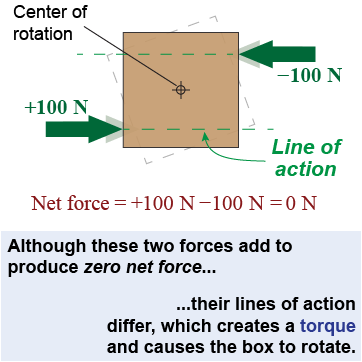|
Consider the two forces acting on the box in the diagram on the right. The net force is zero because the forces are equal and in opposite directions. The box rotates, however, because there is a torque created by these forces. A torque is a twisting action that may be created by forces depending on where they act. 
| 
|
A force creates torque about a particular center point when its line of action does not pass through the center point. The line of action is an imaginary line in the direction of a force passing though the force’s point of application on an object. Both forces in the illustration at right create torque. 
|
Torque is usually represented by the lower case Greek letter τ (“tau”). The torque τ is the length of the lever arm r times the magnitude of the force F. 
|
| (8.2) | | | τ | = | torque (N m) | | r | = | distance from center to line of action (m) | | F | = | force (N) |
| Torque
|
|
The lever arm is the perpendicular distance from the center of rotation to the line of action of the force. The torque created by a particular force depends on the length of the lever arm. A longer lever arm means larger torque even through the force may not change. When the line of action passes through the center of rotation, however, the lever arm is zero. In this case the torque is also zero no matter how large a force is applied. 
|
The units of torque are force times distance, or newton-meters. A torque of 20 N m is created by a force of 100 N acting with a lever arm of 0.2 m. Because torque is a product of two variables, it is possible to create the same torque with different forces. For example, a 20 N force applied with a lever arm of 1 m also produces a torque of 20 N m. 
| 
 |
If more than one torque acts on an object, the torques are combined to determine the net torque. If the torques tend to make an object spin in the same direction (clockwise or counterclockwise), they are added together. If the torques tend to make the object spin in opposite directions, the torques are subtracted. To keep the addition and subtraction straight, torques that tend to cause counterclockwise rotation are usually assigned positive values. Torques that tend to cause clockwise rotation are therefore negative. The total torque is calculated by adding up each individual torque, keeping track of the positive and negative signs. 
|
In English units, torque is usually expressed in pound-feet. A torque of one pound-foot represents the twisting action of a one pound force with a lever arm of one foot. 
 |
In English units, the pound-foot is a unit of torque equivalent to the torque caused by a one pound force acting with a lever arm of one foot. These units might be found in the specifications for the torque of a high-performance automobile. The pound-foot should not be confused with the foot-pound, an English unit for work or energy; as you will learn in the next chapter, work can be expressed as a force of one pound applied for a distance of one foot. 
|
Jamir is struggling to loosen a bolt with a short wrench. If he uses a longer wrench but pushes with the same force, what happens to the torque generated? - It increases.
- It decreases.
- It does not change.
- No torque is generated.
 |
The answer is a. Torque is the product of the force applied and the perpendicular distance from where the force is applied. A greater distance will yield a greater torque. (Jamir was using the same force, so both the magnitude and direction of his force were the same in both cases.) 
|

